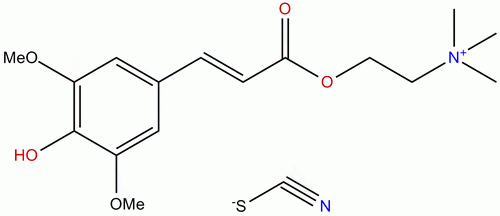
Sinapine thiocyanateCAS No.:7431-77-8
|
||||||||||
 |
|
|
||||||||

| Catalogue No.: | BP1309 |
| Formula: | C16H24NO5+ |
| Mol Weight: | 310.369 |
Product name: Sinapine thiocyanate
Synonym name:
Catalogue No.: BP1309
Cas No.: 7431-77-8
Formula: C16H24NO5+
Mol Weight: 310.369
Botanical Source: Rape seed meal
Physical Description:
Type of Compound: Phenylpropanoids
Purity: 95%~99%
Analysis Method: HPLC-DAD or/and HPLC-ELSD
Identification Method: Mass, NMR
Packing: Brown vial or HDPE plastic bottle
Storage: Store in a well closed container, protected from air and light. Put into refrigerate or freeze for long term storage.
Whenever possible, you should prepare and use solutions on the same day. However, if you need to make up stock solutions in advance, we recommend that you store the solution as aliquots in tightly sealed vials at -20℃. Generally, these will be useable for up to two weeks.
The product could be supplied from milligrams to grams
Inquire for bulk scale.
Description:
Sinapine thiocyanate has antioxidant activities and is hepatoprotective in a dose-dependent manner, implies that Brassica rapa seeds could be developed as a functional food for hepatoprotection.
References:
《Food and Drug》 2014-03
Stability of Sinapine Thiocyanate from Water Extract of Semen Raphani in Artificial Gastric and Intestinal Juice
To investigate the stability of Sinapine thiocyanate in artificial gastric and intestinal juice gained from the water extract of Semen Raphani.
METHODS AND RESULTS:
HPLC was used to determine the area at different time points of Sinapine thiocyanate in artificial gastric juice with or without pepsin and artificial intestinal juice with or without pancreatin, the mass concentration and average remaining percentage were calculated respectively. Sinapine thiocyanate was more stable in artificial gastric juice than in artificial intestinal juice and most unstable in artificial intestinal juice without pancreatin. The stability of Sinapine thiocyanate was similar in two kinds of artificial gastric juice but considerable different in artificial intestinal juice.
CONCLUSIONS:
The remaining percentage of Sinapine thiocyanate in artificial gastric and intestinal juice, which were relatively stable, were all above 70 %, and that provided reference for the absorption mechanism of Sinapine thiocyanate.